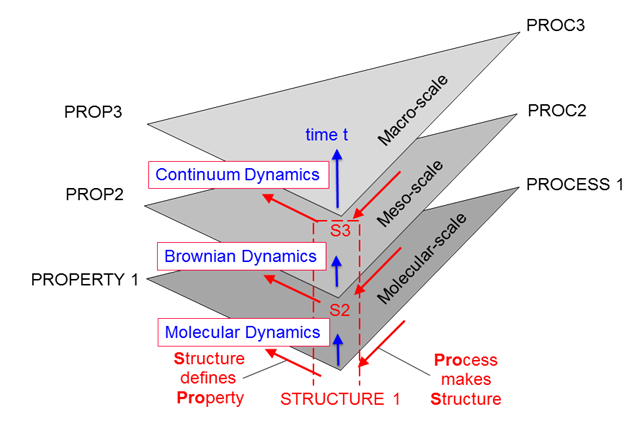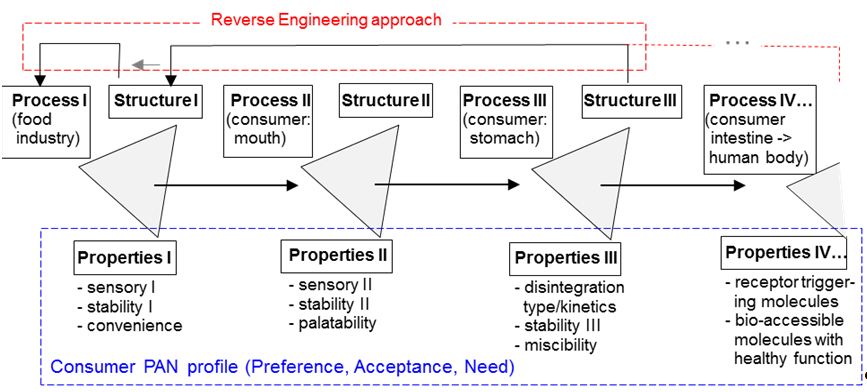About us
The Food Process Engineering group focuses on Process-Structure-Property (S-Pro2) interactions in food/biomaterial systems, which means coupling the fields of food process engineering and food material sciences. The S-PRO2 scheme represents a hierarchical, structure-centred, multi-scale approach considering characteristic length and time scales as guides for problem solving concerning food product and processing developments (Figure 1).
The group’s process engineering research incorporates (A) novel processing methodologies for functional structure tailoring in food systems and (B) gastro-intestinal engineering (EnGI) with respect to optimizing structure disintegration and function release. These two fields are intrinsic parts of an S-PRO2 cascade, which demonstrates the causal relationships between food process, food structure and food product properties from the industrially processed food to its digested state (Figure 2). From this, an innovative reverse engineering approach has also been developed by the group, deriving - (i) optimized consumer-relevant food products with new functional structure and (ii) their processing by new technologies - from the properties/functions such food structure and its constituents trigger under processing, storage/distribution, food preparation or human digestion conditions in specific sections of the GI-tract from the mouth to the colon. Considered food properties and functions are seen as elements of consumer’s “Preference, Acceptance and Need Profile” (PAN) integrating (a) consumer-relevant food quality characteristics (P: e.g. sensory properties, stability/shelf life, convenience aspects), (b) socio-political requirements (A: e.g. safety, traceability, GMO free, animal welfare, ethnic / religious / vegetarian aspects) and (c) health supporting functions (N: e.g. with positive impact on deficiencies, satiation / satiety / weight control, performance, development, aging, etc.).
The methodological scientific toolbox for process analyses contains the main tools of (i) processing experiments from micro-fluidics to pilot scale, (ii) non-equilibrium thermodynamics based and empirical modelling, as well as (iii) multi-scale numerical simulation from molecular dynamics to continuum mechanics. This is complemented by analytical and modelling tools for food material characterization with major expertise in non-Newtonian rheology, multi-scale bulk / interfacial structure characterization techniques using light- (SALS), neutron- (SANS) or x-ray- (SAXS, WAXS) scattering or diffraction as well as ultrasound and microscopic techniques (CLSM, SEM, TEM).
As of September 2015, the Food Process Engineering group consists of 24 scientists (16 Ph.D.s, two postdoctoral scientists, three senior scientists, one visiting professor), five technicians, and one secretary. The expertise of the senior scientists, postdoctoral scientists, and PhDs is adapted to the three key elements of the S-PRO2 scheme (i) process, (ii) structure and (iii) property, whereas (i) is mainly represented by food, chemical and mechanical engineers, (ii and iii) by material science related food scientists, physicists, and chemists.
Prof. Dr. Peter Fischer is physicist and the materials scientist of the group. He is a lecturer in interfacial sciences and physical characterization methods for foods. Peter Fischer’s research expertise is in bulk and interfacial rheology, structure characterization by scattering techniques (SALS, SANS, SAXS), and micro-fluidics.
Dr. Peter Braun is a chemical engineer by training and lead food engineer in the group. He is a lecturer in process engineering with research expertise in food process and engineering with focus on disperse solids engineering.


